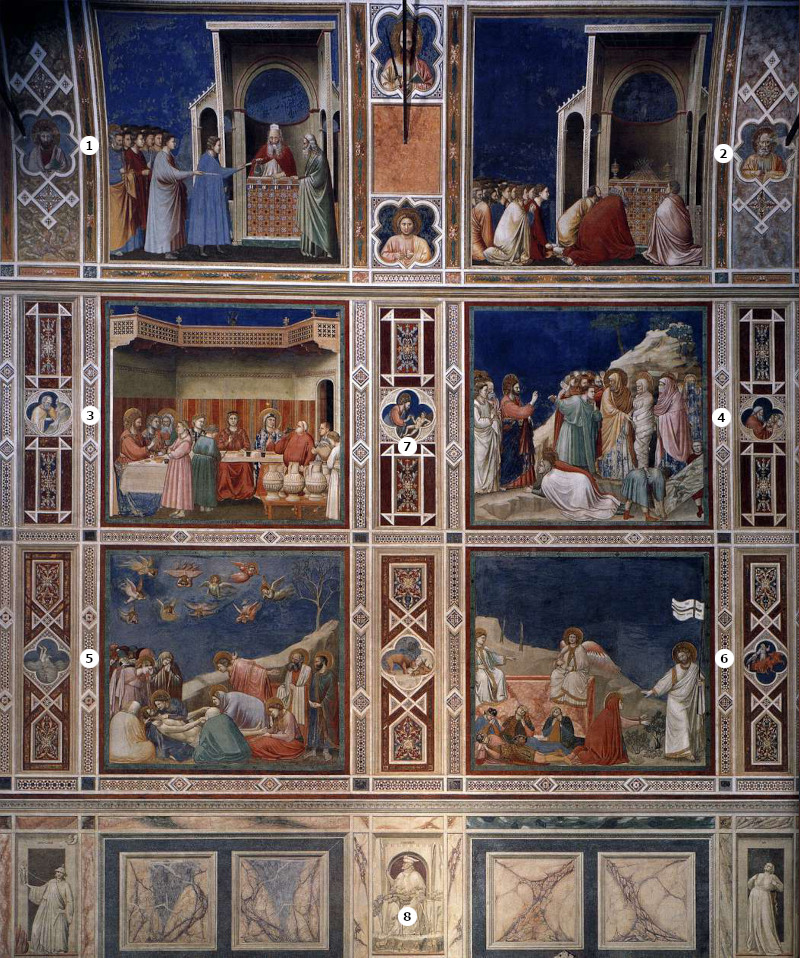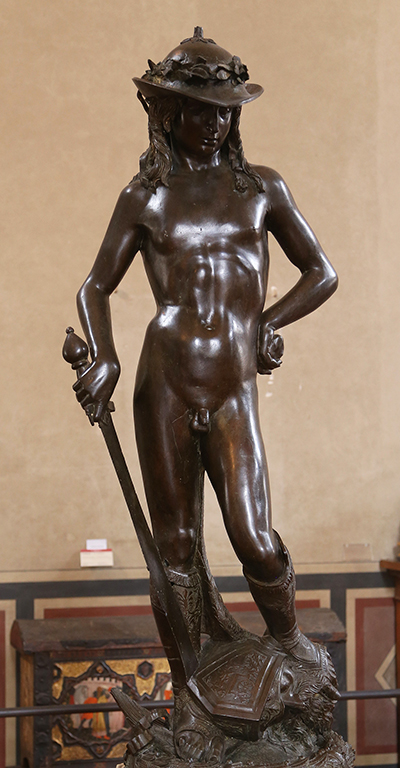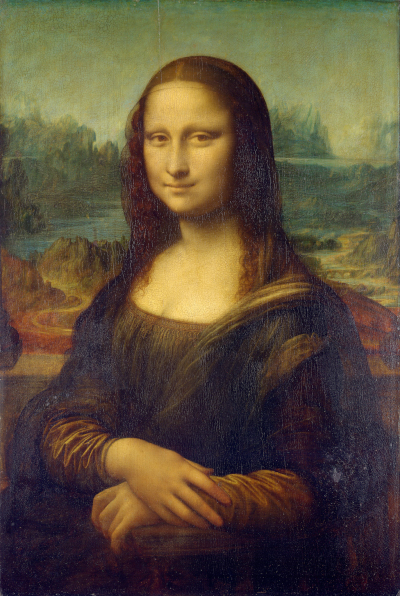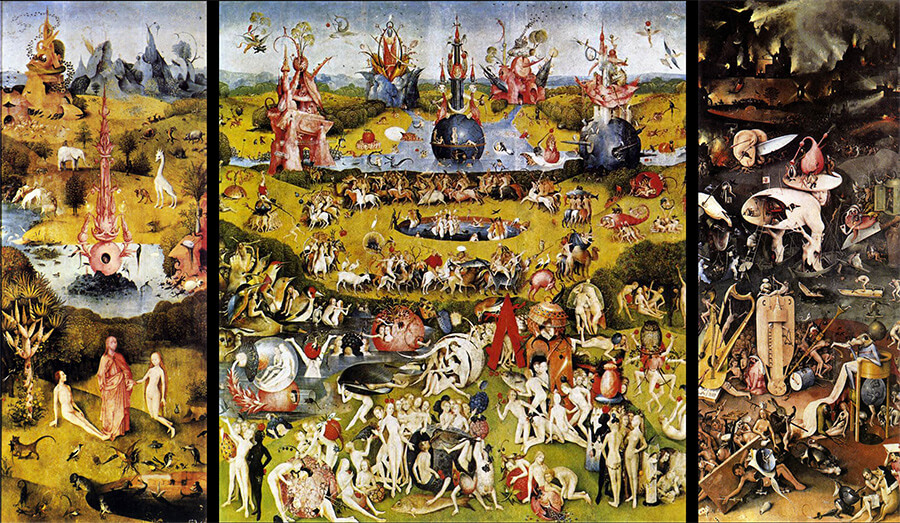Introduction
Overview of the Painting - Giotto's Lamentation (The Mourning of Christ)
Lamentation (The Mourning of Christ) was completed between the period of 1304-06, whilst Giotto di Bondone was fulfilling a wider commission within the Scrovegni Chapel in Padua, Italy. The individual panel fresco is sized at 200 cm x 185 cm.
Historical context of the artwork
The artist worked with around forty assistants on the overall project and at the time of its inception he was still only in his late thirties. It was one of the most significant commissions in his career, financed by the ambitious Enrico Scrovegni, on whom the chapel would be named.
The Lamentation of Christ specifically sits on the lower tier of the north wall of the chapel, with each panel sitting within overall themes related to passages from the Bible. Just within this section of the wall, for example, you will find related artworks such as The Ascent to Calvary, Crucifixion, The Resurrection of Jesus, Ascension and Pentecost.
Description and Analysis of the Artwork
This panel fresco captures the moment at which Christ has been lowered from the cross and placed gently on the ground. As his body lies motionless, friends and family gather around to express their sadness at his demise. Giotto focuses on delivering strong emotions within this piece in order to underline the grief felt by Christ's followers.
In drawing from religious scripture, Giotto incorporates identifiable figures into the scene initially, such as with Mary, the mother of Jesus, Mary Magdalene and John the Apostle, before adding additional people in the background who help to intensify the feeling of sadness which persists throughout the scene.
The artist's technique of making his portraits particularly lifelike was slightly unusual for the period, but helps to connect the viewer to these strong emotions, in a way few other artists were able to achieve at the time. In covering content not explicitly outlined in the Bible, Giotto is afforded considerable artistic licence, enabling him to display all of his unique artistic strengths.
Giotto took a lead role in directing the large series of frescoes within the Scrovegni Chapel, ensuring a consistent look and style throughout. His assistants worked quickly to ensure each design was completed to his satisfaction prior to the fresco plaster drying. Lamentation remains one of the most emotionally charged items in this highly regarded series of works.
 Giotto.jpg)
Key Features of the Painting - Image Annotations
- Christ lies prostrate after being taken down from the cross
- Mary, the mother of Jesus, cradles his head
- Mary Magdalene supports his feet
- John the Apostle expresses grief with outstretched arms
- Nicodemus and Joseph of Arimathea ready to prepare Jesus' body for entombment
- Cherubs respond to the collective grief
- Lifeless tree reflects general mood of sorrow
- Other friends join the gathering

Location within the Scrovegni Chapel - Image Annotations
- The Bringing of the Rods to the Temple
- The Suitors Praying
- Marriage at Cana
- Raising of Lazarus
- Lamentation - The Mourning of Christ
- Resurrection
- Decorative bands between each scene painting
- Tiled footer artworks running the length of the wall
Timeline of Giotto's Major Projects
Visual elements and composition
The overall display is considered by many to be one of the finest series of frescoes in Italian Renaissance history. Lamentation itself features a collection of sorrow and grief, displayed powerfully in the faces of those who mourn the loss of Christ.
The bottom half of the canvas is filled with these emotional figures, positioned in front of a small rock face which helps to frame the composition and also add some aesthetic interest and an element of perspective. Behind that appears to be a faint outline of a larger series of mountains.
Giotto chose not to add too much detail here in order to avoid distracting the eye from the key elements of the scene that lie elsewhere.
In order to underline the significance of this death, Giotto then appends further individuals on the left hand side, but with reduced detail in order to add as many as possible. At the top of the scene we find angels displaying similar expressions of grief and sorrow.
This imagery helps to connect Christ to both humanity as well as the Gods above. There is also the symbolic addition of a dishevelled tree to the right hand side, representing the loss of Christ's life and also the overall theme of sadness and desperation.
Mary, his mother, holds his body, whilst most of the other supporting figures in this scene are used to extend and intensity her own pain and sorrow. Many artists over the centuries have addressed Christ's life and done so in different ways - Murillo, for example, was able to present this icon as if another human, helping followers to build up their faith.
Symbolism and iconography
Symbolism was common throughout European art of the 14th century and despite bringing many innovations to the early Renaissance genre, Giotto himself made use of it in many of his religious depictions. Within Lamentation, the most obvious example would be the lifeless tree to the right hand side which adds to the overall mood of the piece.
The rocky environment helps to illustrate the discomfort suffered by Christ, whilst the golden halos indicate the divinity of several figures within the composition, and continues the common use of iconography within religious art during this period. The open arms of John the Apostle help to symbolise the overall sadness felt by those devoted to Christ upon witnessing his suffering.
Religious Context
The term Lamentation within Christianity can both refer to the emotional suffering of Christ himself, but also in those around him. In the case of this panel painting, clearly, it is the latter. The Bible does not specifically mention the mourning of Christ, but it has regularly been covered by artists across western history, giving the narrative a life of its own, and the passage below explains what occurs immediately afterwards.
After these things Joseph of Arimathea, who was a disciple of Jesus, but secretly for fear of the Jews, asked Pilate that he might take away the body of Jesus, and Pilate gave him permission. So he came and took away his body. Nicodemus also, who earlier had come to Jesus by night, came bringing a mixture of myrrh and aloes, about seventy-five pounds in weight. So they took the body of Jesus and bound it in linen cloths with the spices...
John 19:38-42, The Holy Bible
Notable artistic techniques used by Giotto
Giotto is highly regarded for the natural appearance of his portrait figures, and Lamentation provides the perfect example of that. Whilst incorporating the symbolism common for this period, he did not always follow the other common methods of the day, with most other artists preferring stylized representations which continued the Byzantine traditions.
It was perhaps his skilled use of perspective and other spatial techniques alongside his impressive depiction of emotion within his work which helped to evolve western art of that period, paving the way for the advancements of later stages of the Italian Renaissance. He would also help to connect the public with religious scripture by humanising many of its leading figures.
Reception and Legacy
Public reception over the centuries
Public and academic response to Giotto's work within the chapel has tended to focus on the overall series of frescoes that he produced, alongside his assistants, rather than any of the individual artworks specifically. That said, Lamentation has consistently received more attention than most other items in the series, thanks to the powerful emotions which run through the piece.
Deposition [Lamentation, the Mourning of Christ] is also famous, with its emotional fulcrum shifted down and to the left, to the encounter between Mother and Son.
The figures are extraordinarily sturdy, like blocks of stone: the two cloaked figures seen from the back; Martha in her lilac veil; the powerful Madonna, a true image of grief, is as beautiful as Mary Magdalen, in a very delicate posture, and St. John enveloped in a cloak that falls majestically, who opens his arms to define the space. The cherubs respond to this grief, and nature itself strips the leaves of the tree.
Giotto, page 188, Francesca Flores d'Arcais, Abbeville Press
Conservation and preservation efforts
The chapel itself was announced as an official UNESCO World Heritage Site as recently as 2021 and this was predominantly due to the fresco cycle created by Giotto.
Its inclusion with UNESCO has led to an increase in tourism to the chapel and also its inclusion on a greater number of tour itineraries, meaning it is fairly easy to arrange a visit to this popular spot.
Alternative Interpretations of Lamentation by other Notable Artists
The Mourning of Christ is a scene found on countless occasions in Renaissance art, from a time when religion was particularly involved in all sections of society. The bible tells followers of how Christ was mourned after being taken from the cross.
The topic of Lamentation was specifically covered by other famous artists such as Albrecht Durer, Peter Paul Rubens, Raphael, Rembrandt and Sandro Botticelli. Most of the influence from Renaissance art would come from Italy but there were also considerable achievements from artists elsewhere in the continent, such as Germany, the Netherlands, France and Spain.
Painting Details
- Title: Lamentation (The Mourning of Christ)
- Artist: Giotto
- Genre: Proto Renaissance
- Location: Scrovegni Chapel, Padua, Italy
- Dimensions: 200 by 185 centimetres (79 in × 73 in)
- Medium: Fresco
- Created: c.1304-c.1306
FAQs
References
More Renaissance Artists



 Giotto.jpg)
 Giotto.jpg)













